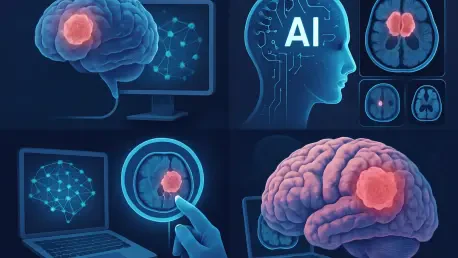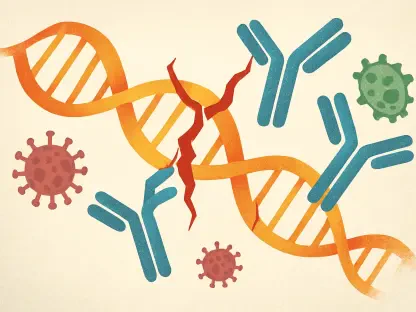In the realm of cancer research, few challenges loom as large as gliomas, with glioblastoma standing out as the most aggressive and prevalent primary brain tumor, comprising roughly 55% of all cases. This devastating disease is notorious for its late-stage diagnosis, resistance to conventional therapies, and a prognosis that offers little hope, often leaving patients with mere months of survival even after aggressive treatment. The complexity of glioblastoma—manifesting as both a solid tumor and an infiltrating disease—has confounded scientists and clinicians for decades, rendering standard approaches largely palliative. However, a transformative wave of innovation driven by artificial intelligence (AI) and genomics is beginning to shift the landscape, offering new insights into the intricate biology of gliomas. Cutting-edge research from leading institutions is harnessing these technologies to redefine how this deadly condition is diagnosed and treated, sparking a renewed sense of optimism. This exploration delves into the latest advancements, highlighting how AI and genomic tools are unraveling the mysteries of tumor behavior and paving the way for personalized medicine that could one day turn the tide against glioblastoma.
Unraveling the Intricacies of Glioma Biology
The biological complexity of gliomas, particularly glioblastoma, presents a formidable barrier to effective treatment, as these tumors are far from uniform in their makeup. Within a single tumor, multiple subclones with distinct genetic profiles can coexist, each potentially responding differently to therapies, which often leads to recurrence even after initial interventions appear successful. This heterogeneity is further complicated by glioblastoma’s dual nature, where it exists as a solid mass—frequently located in the frontal or temporal lobes—and as an infiltrating disease that intermingles with healthy brain tissue. Such characteristics make complete surgical removal a near-impossible task, leaving residual cancer cells to fuel further growth. Understanding this intricate diversity is critical, as it underscores why a blanket approach to treatment fails to address the nuanced challenges posed by each patient’s tumor.
Beyond the structural challenges, the adaptability of gliomas adds another layer of difficulty for researchers striving to develop lasting solutions. The tumor’s ability to evolve under therapeutic pressure, forming resistant subclones, highlights the need for a deeper dive into its molecular underpinnings. Experts argue that treating glioblastoma as a singular entity is akin to addressing all forms of leukemia with a single protocol—an oversimplification that ignores the unique drivers of each case. This realization has spurred efforts to map out the specific genetic and environmental factors at play, setting the stage for diagnostic tools and therapies that can target the disease with greater precision. The push toward molecular subclassification is not just a scientific endeavor but a necessary shift to improve patient outcomes in a field long plagued by stagnation.
Challenges in Current Glioblastoma Treatments
For nearly two decades, the standard of care for glioblastoma has remained anchored in the Stupp protocol, a regimen that combines surgical resection with radiation therapy and chemotherapy using temozolomide. While this approach can extend survival and maintain a degree of quality of life for some patients, it falls short of offering a cure, serving primarily as a means to manage tumor growth rather than eliminate it. The lack of significant updates to this protocol over such an extended period reflects a broader frustration within the medical community, as progress in therapeutic innovation has been painfully slow. Patients are often left with limited options, grappling with a disease that continues to outpace the tools available to combat it.
Several entrenched barriers contribute to this persistent stagnation in glioblastoma treatment, making it a uniquely challenging cancer to address. Late-stage diagnosis remains a critical issue, as symptoms often emerge only after the tumor has advanced significantly, reducing the window for effective intervention. Additionally, the tumor’s invasive nature complicates surgical efforts, while its resistance to chemotherapy and radiation—often bolstered by an immunosuppressive microenvironment—further diminishes the impact of standard therapies. These obstacles highlight the urgent need for novel strategies that can bypass the limitations of current methods, pushing researchers to explore beyond traditional frameworks and seek out solutions that address the root causes of treatment failure.
Revolutionizing Diagnostics with Artificial Intelligence
One of the most promising frontiers in glioma research lies in the application of artificial intelligence, which is transforming how tumors are diagnosed and monitored with unprecedented accuracy. At NYU Langone Medical Center, a pioneering team has leveraged machine learning to create a DNA methylation-based classification system that identifies over 180 subtypes of central nervous system tumors. This groundbreaking approach reveals more than 10 distinct molecular entities within what was previously categorized broadly as glioblastoma, offering a far more detailed understanding of the disease’s diversity. Such precision in classification is a crucial step toward developing therapies that are tailored to the specific genetic makeup of a patient’s tumor, moving away from the generalized treatments that often fall short.
Complementing these efforts, researchers at Mass General Brigham’s Artificial Intelligence in Medicine Program are harnessing deep learning to enhance prognostic capabilities through the analysis of sequential MRI scans. Their innovative models have demonstrated remarkable accuracy—ranging from 75 to 89%—in predicting glioma recurrence among pediatric patients, a development that could significantly improve early intervention strategies. By mimicking the interpretive skills of clinicians over time, these AI tools not only boost diagnostic precision but also enable risk-adapted surveillance plans. This means that low-risk patients could avoid the burden of frequent imaging, while high-risk cases receive timely attention, optimizing resource allocation and patient care in a field desperate for actionable advancements.
Genomic Innovations Unlocking Tumor Secrets
Parallel to AI-driven progress, genomic research is shedding light on the intricate mechanisms that fuel glioma development and resistance, offering hope for more effective interventions. At City of Hope, scientists are employing spatial transcriptomics and tumor-normal DNA sequencing to investigate the role of extrachromosomal DNA (ecDNA) in tumor evolution. Their findings reveal how ecDNA creates subclonal regions within tumors, each with unique genetic profiles that contribute to therapy resistance, particularly in harsh conditions like hypoxia. This insight into the dynamic interplay between genetic elements and tumor microenvironments is vital for understanding why gliomas often rebound after treatment, providing a foundation for strategies that could disrupt these protective adaptations.
Another significant stride in genomic exploration comes from the use of Hi-C chromatin conformation capture technology at NYU Langone, where researchers are uncovering hidden structural variants in glioma genomes. This method offers a three-dimensional perspective on tumor DNA, identifying critical drivers in non-coding regulatory regions that standard clinical tests typically overlook. By pinpointing these previously undetectable factors, the approach enhances biomarker discovery and opens new avenues for targeted therapies. Such detailed mapping of the genomic landscape is essential for moving beyond surface-level observations of gliomas, equipping scientists with the tools to address the disease at its molecular core and potentially alter its deadly trajectory.
Paving the Way for Precision Medicine
The overarching goal of these technological breakthroughs is to transition from the outdated, one-size-fits-all Stupp protocol to a model of precision medicine that accounts for the unique characteristics of each glioma case. By integrating insights from ecDNA mapping and molecular profiling, researchers are identifying specific genetic drivers and environmental factors that could serve as therapeutic targets. This shift holds the promise of treatments customized to individual patients, addressing the specific vulnerabilities of their tumors rather than relying on broad, often ineffective methods. The potential to improve outcomes through such tailored approaches represents a significant departure from the historical challenges that have defined glioblastoma care.
Moreover, the integration of AI-driven tools into clinical practice could further personalize patient management by enhancing early detection and recurrence prediction. The ability to stratify patients for clinical trials based on molecular signatures ensures that experimental therapies are directed to those most likely to benefit, maximizing the impact of research efforts. While hurdles remain in translating these cutting-edge discoveries into routine medical practice, the momentum is undeniable. The combined power of AI diagnostics and genomic insights is setting a new standard for how gliomas are approached, fostering a cautious optimism that personalized solutions could soon become a tangible reality for those affected by this relentless disease.
Future Horizons in Glioma Treatment
Reflecting on the strides made in glioma research, it’s clear that the field stood at a critical juncture in recent years, balancing persistent challenges with remarkable technological advancements. The frustration over stagnant treatment protocols was met with innovative responses, as AI and genomics began to peel back the layers of glioblastoma’s complexity. From the molecular subclassification efforts at NYU Langone to the ecDNA studies at City of Hope and AI-driven predictions at Mass General Brigham, a multifaceted assault on the disease took shape, each contribution building toward a deeper understanding of tumor behavior.
Looking ahead, the focus must shift to actionable steps that bridge the gap between research and clinical impact. Accelerating the translation of AI and genomic tools into accessible diagnostic and therapeutic options is paramount, as is the need for collaborative efforts to refine these technologies for broader use. Investment in long-term studies to track the efficacy of personalized treatments will be crucial, ensuring that the optimism of today transforms into measurable benefits for patients tomorrow. As the journey continues, the integration of diverse scientific approaches promises to redefine the fight against gliomas, offering a beacon of hope for a future where this devastating cancer no longer holds an unbreakable grip.









